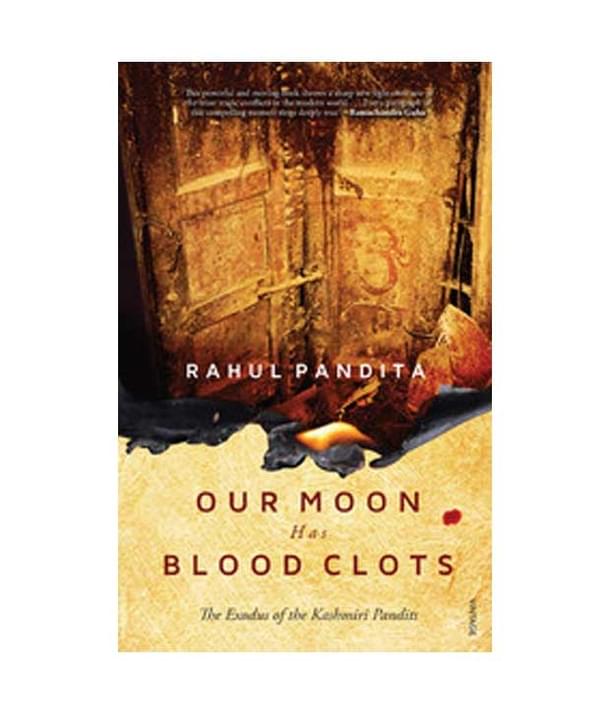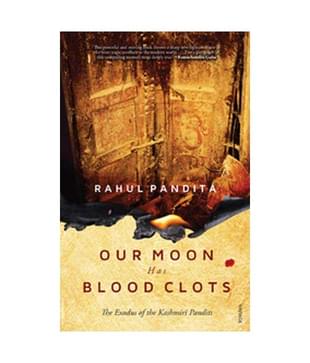Reviews
Book Review - Our Moon Has Blood Clots
Sunanda Vashisht
Mar 04, 2013, 02:22 PM | Updated Apr 29, 2016, 01:48 PM IST
Save & read from anywhere!
Bookmark stories for easy access on any device or the Swarajya app.


A journey to the center of the Heart
Truth has a remarkable quality about it. It reverberates loud and clear even when it is whispered. It can travel a long way even when it is feeble. Truth never gets tired, it never rests nor does it ever die. In fact, you can smell truth from the distance. If I had to describe Rahul Pandita’s latest book ‘Our Moon has blood clots’ in one word it would be ‘Truth’. Truth that has been silenced again and again and yet like a phoenix rises from the ashes to tell the story.
‘Our Moon has blood clots’ is a book that needed to be written. Exodus of Hindus of Kashmir, also known as Kashmiri Pandits is a blot on our secular fabric. India’s secularism was put to test in Kashmir valley when Pakistan sponsored armed jihad began in 1989-90. Sadly Government of India failed to protect the miniscule minority of Hindus. As tragic and shameful as their exodus is, even more tragic are the lies that have been woven around the episode. It has been a sustained campaign to project exodus as a ‘self-imposed exile’. Another lie that has been repeated million times in the hope of it becoming truth is that then Governor Jag Mohan somehow conspired with Pandits and coaxed them to leave their homes to teach Muslims of valley a lesson.
For last 23 years, Pandit organizations and independent bloggers have worked consistently and diligently to present their side of the story, but their narrative gets lost in the din. Since Hindus are not considered minority in India nor does anyone ever think that they could be aggrieved and wronged too, the real story of Pandit Exodus has been relegated to a few blogs. Therefore, Rahul Pandita’s book is very valuable for it presents the real truth without the need to balance it with any other narrative. In his well-written, gut wrenching memoir, Pandita demolishes every lie that has been peddled in last two decades.
Pandits are often accused of cowardice. ‘After all this is not the only riot that has happened in the country, No one flees their homes after a riot’ is what is often heard in liberal circles. It is very important to remember that what happened in 89-90 in Kashmir was not a riot. A riot is a sudden spurt of violence between two communities with one community somehow provoking the other. Pandit Exodus was not a result of rioting. As Pandita painstakingly covers the simmering discontent of 80’s that led to the lid finally getting blown over, it is clear that Pandits were punished for their ‘Indianness’. There was a conscious effort to kill, rape and terrorize them to send Government of India the message that Jihad had been announced in the valley. There was absolutely no provocation from Pandits. Jihadis had figured that first line of defense in valley was provided by this tiny community who swore by the constitution of India. They had to be eliminated one way or the other. Slogans like ‘Flee, convert or die’ were constantly heard from mosques around the valley. Centuries of Persecution of Hindus of Kashmir had resulted in them being only 5% of the population. There was no way for them to fight back. Even if they picked up guns they would have been completely decimated. So those who were not killed fled the valley.
Another argument, one often hears and this comes mostly from the valley, is that ‘Azadi is a secular struggle for self-determination”. One wonders why secular struggle for self-determination had to be announced on Jan 19, 1990 from all the mosques together. One wonders why slogans like ‘Aazadi ka matlab kya la ilaha illalaha’ ‘Yahan kya chalega nizam e mustafa’ and ‘Ae zaalimon, ae kafiron, Kashmir hamara chod do’ had to be coined. Rahul Pandita has vividly described the night of Jan 19, 1990 when the bugle of Jihad was finally blown in the Kashmir. From the pulpits of mosques the faithful were beckoned and the infidels were warned with dire consequences. Everything about that night and later had Islamic overtones. It was clear that this was an Islamic movement to overthrow secular India. Despite all the slogans and selective killings, Pandita recalls that a Pandit leader, Mr. H N Jattu wrote to the JKLF asking about the fate of Hindus now that the armed insurgency had taken over. His letter was promptly replied when his colleague AshoK Qazi was murdered in the most brutal fashion. This left no ambiguity that Jihadis wanted Hindus out at any cost.
Another myth that Rahul Pandita sets out to break forever is that majority of Muslims had nothing to do with the exodus of Pandits. This was the doing of gun wielding terrorists and larger Muslim population could do nothing to stop them. Pandita has given examples of how Muslims of the valley colluded with the militants to terrorize Pandits. In one such heart breaking episode, Pandita recalls how a telecom engineer B K Ganju found his name on the ‘Terrorist Hit-list’. When Militants came looking for him, he hid in the huge drum used for storing rice. When they couldn’t find him they left but were promptly called by a Muslim neighbor who had seen Ganju hiding in the drum. Militants pumped bullets into his belly and killed him instantly. There are many such incidents that happened around the valley where neighbors, friends, colleagues gave vital information about the Pandits to the militants. It is a fact that not everyone was armed. Some local Muslim boys had trained in camps in POK and had guns, but if they had not found support amongst the local population in the valley maybe the exodus would not have happened. So for ‘liberal’ muslims in the valley to shrug off responsibility and say Jagmohan arranged for the exodus is nothing but a blatant lie of enormous proportion.
Rahul Pandita has explained the time line of Jagmohan taking over as Governor of the valley second time in 1990, after Farooq Abdullah did his vanishing act when the President’s rule was announced. Jagmohan was not in the valley on Jan 19, 1990. He was stuck in Raj Bhavan in Jammu. There was nothing he could have done to either facilitate or prevent the exodus. There was complete break of law and order; nobody was in control on that fateful night. There was absolutely no one who could have come to the rescue of Pandits. It was a night of betrayal, brutality and violence. It was a night when neighbors turned on neighbors, it was a night when friendships were sacrificed, and it was a night when Kashmiriyat (if it existed) died.
Another lie that is often heard in news rooms around the country is that after exodus the tiny numbers of Hindus are still left in the valley and they have not been harmed. Pandita dismisses this lie when he poignantly describes Wandhama massacre of 1998, where 23 members of one family were gunned down by the militants. Only one 14 year old boy who hid himself in the attic survived to tell the story of that night when terrorists lined up all the members of the family and shot them dead. Nobody came to their rescue and actually the neighbors turned up the loudspeakers in the nearby mosques to muffle their voices for help. Much later when the police showed up, did the local women come and start wailing over the dead bodies. Vinod Dhar, the lone survivor of the massacre, who Rahul Pandita interviewed for this book, called it an act enacted for the photo ops. Similarly NandiMarg massacre of 2003 where 24 Hindus including children were shot dead is a reminder that Pandits are not safe in the valley anymore.
1446 Pandits who have been rehabilitated in the valley recently and given jobs have much sadder stories to tell. They have been restricted to small ghettos and are safe only in the compound where make shift apartments have been built for them to live. They face discrimination in the work environment and have very little sense of security. The valley has been Islamized and they feel out of place and unwanted. Only reason they are there is because they desperately need the money to run their families.
In ‘Our Moon has blood clots’, Rahul Pandita takes us on his personal journey which is entwined with the history of Kashmiri Pandits. His brother Ravi who was killed by the terrorists and who this book has been dedicated to has left an indelible scar on him. His mother as a child lived through the invasion of Kashmir by Pakistani Tribals in 1947. A trail of death and destruction was left behind by blood thirsty tribals of Waziristan who spared no infidels that came in their way. They either killed or forced Hindus to convert to Islam. The tribal invasion of 1947 has more or less been forgotten in the secular discourse of Kashmir and I am glad Pandita takes it up in detail.
‘Our Moon has Blood clots’ is a genuine attempt to challenge the convoluted narrative of Kashmir which is always presented on the world stage as a war between Muslims seeking Azaadi and mighty Indian State that has been thwarting their struggle for self-determination. No one is interested in the story of small community of Pandits who were forced to leave their 5000 year old home and heritage by the same people who seek ‘self-determination’.
There is no immediate hope that Pandits will be able to return home. Their story however must be told and retold because there are lessons to be learnt. This book has ruffled feathers and columns after columns have been written attacking the author. The book will prevail as will Pandits, because truth never attacks, it only prevails.
Sunanda Vashisht is a columnist and political commentator. She is Chief Academic Council at Jonaraja Institute of Genocide and Atrocities Studies.





